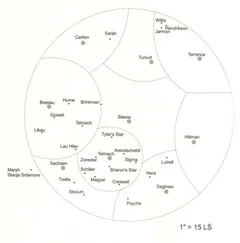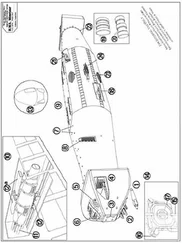David Weber - More Than Honor
Здесь есть возможность читать онлайн «David Weber - More Than Honor» весь текст электронной книги совершенно бесплатно (целиком полную версию без сокращений). В некоторых случаях можно слушать аудио, скачать через торрент в формате fb2 и присутствует краткое содержание. Жанр: Фантастика и фэнтези, на английском языке. Описание произведения, (предисловие) а так же отзывы посетителей доступны на портале библиотеки ЛибКат.
- Название:More Than Honor
- Автор:
- Жанр:
- Год:неизвестен
- ISBN:нет данных
- Рейтинг книги:3 / 5. Голосов: 1
-
Избранное:Добавить в избранное
- Отзывы:
-
Ваша оценка:
- 60
- 1
- 2
- 3
- 4
- 5
More Than Honor: краткое содержание, описание и аннотация
Предлагаем к чтению аннотацию, описание, краткое содержание или предисловие (зависит от того, что написал сам автор книги «More Than Honor»). Если вы не нашли необходимую информацию о книге — напишите в комментариях, мы постараемся отыскать её.
More Than Honor — читать онлайн бесплатно полную книгу (весь текст) целиком
Ниже представлен текст книги, разбитый по страницам. Система сохранения места последней прочитанной страницы, позволяет с удобством читать онлайн бесплатно книгу «More Than Honor», без необходимости каждый раз заново искать на чём Вы остановились. Поставьте закладку, и сможете в любой момент перейти на страницу, на которой закончили чтение.
Интервал:
Закладка:
The heart of any grav wave is far more powerful than its fringes, or, put another way, a "grav wave" consists of many layers of "grav eddies." For the most part, all aspects of the wave have the same basic orientation, but it is possible for a wave to include counter-layers of reverse "flow" at unpredictable vertical levels. Despite the size of a grav wave, most of hyper-space is free of them; the real monsters that are more than ten or fifteen light-years wide are rare, and even in hyper the distances between them are vast, though the average interval between grav waves becomes progressively shorter as one translates higher into the hyper bands. The great danger of grav waves to early-generation hyperships lay in the phenomenon known as "grav shear." This is experienced as a vessel moves into the area of influence of a grav wave and, even more strongly, in areas in which two or more grav waves impact upon one another. At those points, the gravitational force exerted on one portion of the vessel's structure might be hundreds or even thousands of times as great as that exerted on the remainder of its fabric, with catastrophic consequences for any ship ever built.
In theory, a ship could so align itself as to "slide" into the grav wave at an extremely gradual angle, avoiding the sudden, cataclysmic shear which would otherwise tear it apart. In practice, the only way to avoid the destructive shearing effect was to avoid grav waves altogether, yet that was well nigh impossible. Grav waves might be widely spaced, but it was impossible to detect them at all until a ship was directly on top of one, and with no way to see one coming, there was no way to plot a course to avoid it. It was possible to recognize when one actually entered the periphery of a grav wave, and if one were on exactly the right vector, prompt emergency evasion gave one a chance (though not a good one) of surviving the encounter, but the grav wave remained the most feared and fearsome peril of hyper travel.
Then, in 1246 pd, the first phased array gravity drive, or impeller, was designed on Beowulf, the colonized world of the Sigma Draconis System. This was a reactionless sublight drive which artificially replicated the grav waves which had been observed in hyper-space for centuries. The impeller drive used a series of nodal generators to create a pair of stressed bands in normal-space, one "above" and one "below" the mounting ship. Inclined towards one another, these produced a sort of wedge-shaped quasi-hyper-space in those regions, having no direct effect upon the generating vessel but creating what might be called a "tame grav wave" which was capable of attaining near-light speeds very quickly. Because of the angle at which the bands were generated relative to one another, the vessel rode a small pocket of normal-space (open ahead of the vessel and closing in astern) trapped between the grav waves, much as a surfboard rides the crest or curl of a wave, which was driven along between the stress bands. Since the stress bands were waves and not particles, the "impeller wedge" was able, theoretically, at least, to attain an instantaneous light-speed velocity. Unfortunately, the normal-space "pocket" had to deal with the conservation of inertia, which meant that the effective acceleration of a manned ship was limited to that which produced a g force the crew could survive. Nonetheless, these higher rates of acceleration could be maintained indefinitely , and no reaction mass was required; so long as the generators had power, the drive's endurance was effectively unlimited.
In terms of interstellar flight, however, the impeller drive was afflicted by one enormous drawback which was not at first appreciated. In essence, it enormously increased the danger grav shear had always presented to reactor drive vessels, for the interference between the immense strength of a grav wave and the artificially produced gravitic stress of an impeller wedge will vaporize a starship almost instantly.
In the military sphere, it was soon discovered that although the bow (or "throat") and stern aspects of an impeller wedge must remain open, additional "sidewall" grav waves could be generated to close its open sides and serve as shields against hostile fire, as not even an energy beam (generated using then-current technology) could penetrate a wave front in which effective local gravity went from zero to several hundred thousand gravities. The problem of generating an energy beam powerful enough to "burn through" even at pointblank ranges was not to be solved for centuries, but within fifty years grav penetrators had been designed for missile weapons, which could also make full use of the incredible acceleration potential of the impeller drive. Since that time, there has been a constant race between defensive designers working new wrinkles in manipulation of the gravity wave to defeat new penetrators and offensive designers adapting their penetrators to defeat the new counters.
The interstellar drawbacks of impeller drive became quickly and disastrously clear to Beowulf's shipbuilders, and for several decades it seemed likely that the new drive would be limited solely to interplanetary traffic. In 1273 pd, however, the scientist Adrienne Warshawski of Old Terra recognized a previously unsuspected FTL implication of the new technology. Prior to her Fleetwing tests in that year, all efforts to employ it in hyper-space had ended in unmitigated disaster, but Dr. Warshawski found a way around the problem. She had already invented a new device capable of scanning hyper-space for grav waves and wave shifts within five light-seconds of a starship (to this day, all grav scanners are known as "warshawskis" by starship crews), which made it possible to use impeller drive between hyper-space grav waves, since they could now be seen and avoided.
That, alone, would have been sufficient to earn Warshawski undying renown, but beneficial as it was, its significance paled beside her next leap forward, for in working out her detector, Dr. Warshawski had penetrated far more deeply into the nature of the grav wave phenomenon than any of her predecessors, and she suddenly realized that it would be possible to build an impeller drive which could be reconfigured at will to project its grav waves at right angles to the generating vessel. There was no converging effect to move a pocket of normal-space, but these perpendicular grav fields could be brought into phase with the grav wave, thus eliminating the interference effect between impellers and the wave. More, the new fields would stabilize a vessel relative to the grav wave, allowing a transition into it which eliminated the traditional dangers grav shear presented to the ship's physical structure. In effect, the alterations she made to Fleetwing to produce her "alpha nodes" provided the ship with gigantic, immaterial sails: circular, plate-like gravity bands over two hundred kilometers in diameter. Coupled with her grav wave detector to plot and "read" grav waves, they would permit a starship to literally "set her sails" and use the focused radiation hurtling along hyper-space's naturally occurring grav waves to derive incredible accelerations.
Not only that, but the interface between sail and natural grav wave produced an eddy of preposterously high energy levels which could be "siphoned off" to power the starship. Effectively, once a starship "set sail" it drew sufficient power to maintain and trim its sails and also for every other energy requirement and could thus shut down its onboard power plants until the time came to leave hyper-space. A Warshawski Sail hypership thus had no need for reaction mass, required very little fuel mass, and could sustain high rates of acceleration indefinitely, which meant that the velocity loss associated with "cracking the wall" between hyper bands could be regained and that use of the upper bands was no longer impractical.
Читать дальшеИнтервал:
Закладка:
Похожие книги на «More Than Honor»
Представляем Вашему вниманию похожие книги на «More Than Honor» списком для выбора. Мы отобрали схожую по названию и смыслу литературу в надежде предоставить читателям больше вариантов отыскать новые, интересные, ещё непрочитанные произведения.
Обсуждение, отзывы о книге «More Than Honor» и просто собственные мнения читателей. Оставьте ваши комментарии, напишите, что Вы думаете о произведении, его смысле или главных героях. Укажите что конкретно понравилось, а что нет, и почему Вы так считаете.












